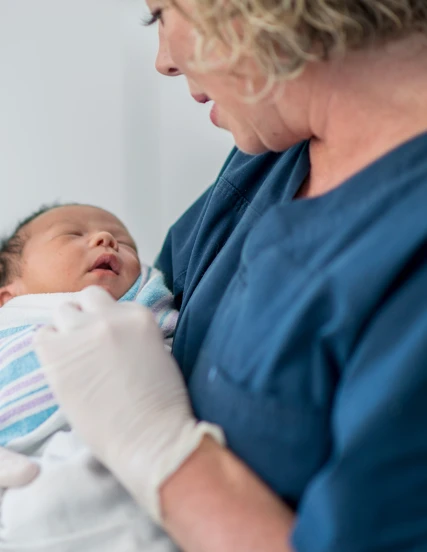Labor and Delivery (L&D) Nurse Career GuideExplore the essential role of a Labor and Delivery (L&D) Nurse, encompassing key responsibilities, required education, and their impact on maternal and newborn care. Labor and Delivery Nurses are pivotal in supporting mothers and newborns through the birthing process, offering guidance, reassurance, and expert care during this transformative experience. This role is perfect for those who are compassionate, calm under pressure, and adept at providing both emotional support and medical care, ensuring the health and safety of both mother and child.
What is a Labor and Delivery Nurse?
Since it’s hard to predict labor duration and potential postpartum challenges, L&D Nurses often form unique bonds with patients and their families, as they’re one of the most consistent points of support while in the hospital. Because of this, the best L&D Nurses are compassionate and clear communicators. At a moment when everything is moving and changing at a rapid pace, it’s important for L&D Nurses to be a point of stability for both patients and doctors in the room.
What does a Labor and Delivery Nurse do?
What is the demand for Labor and Delivery Nurses?
- Consistent need for maternal and newborn care: Childbirth is a constant in healthcare, and there is always a need for skilled nurses to assist in the labor and delivery process.
- Specialized skills: L&D Nursing is a specialized field, requiring specific skills and knowledge in maternal and newborn care. This specialization contributes to the steady demand for these professionals.
- Aging workforce: The nursing workforce, in general, is aging, with many nurses nearing retirement. This trend is creating vacancies that need to be filled by new nurses, including those in L&D.
- Healthcare expansion: As healthcare systems expand and access to healthcare improves, more facilities offering maternity services are opening or expanding, increasing the need for L&D Nurses.Population Growth: In areas experiencing population growth, there is a corresponding increase in the number of births, which directly impacts the demand for L&D Nurses.
- Technological and medical advances: Advances in maternal and newborn care often require additional training and expertise, leading to a greater need for well-trained L&D Nurses.
- Emotional and physical support role: L&D Nurses play a crucial role not just in the physical aspects of childbirth but also in providing emotional support and guidance to expectant mothers, a service that is increasingly recognized and valued.
How much does a Labor and Delivery Nurse make?
How do you become a Labor and Delivery Nurse?
Here are the key stages of achieving your career as an L&D Nurse.
- Get an Associate's Degree in Nursing (ADN) or Bachelor of Science in Nursing (BSN) taking elective courses in labor deliveryA strong base of knowledge in all areas of nursing will help you as you move forward into your clinical practice, and further education.
- Pass the NCLEX-RNTo become a Labor and Delivery Nurse, you must pass the NCLEX-RN exam and earn your license as a Registered nurse.
- Work as a Registered Nurse, gaining experience in labor and deliveryOnce a licensed RN, you must gain at least one year of professional experience before being able to pursue a more specialized path.
- Get your Inpatient Obstetric Nursing Certification through the National Certification Corporation
- You’re ready to work as a Labor and Delivery Nurse!As a Labor and Delivery (L&D) Nurse, you’ll help care for mothers and newborns before, during, and after the birth. Your patients will look to you for information, reassurance and guidance in handling a delicate new life, new family member, and entirely new experience. It’s on you to meet their emotions with compassion, address their questions with a calm and honest attitude, monitor their pain with proper treatment and support, and prioritize the health and safety of their newborn.
Where can a Labor and Delivery Nurse work?
- Birthing centers: Birthing centers are healthcare facilities dedicated to a wellness-centric approach to birthing. Here, L&D Nurses function as midwives or doulas, who differ from registered nurses in that they don’t require the same level of medical certifications. However, a Labor & Delivery Nurse’s skill set is applicable and valuable.
- Hospitals: A large majority of L&D Nurses work in hospitals. Here, you’ll have the opportunity to work in the maternity ward in delivery rooms, hospital nurseries, and neonatal care units.
- Patients’ homes: Similar to their roles in birthing centers, L&D Nurses can assist in home births as a midwife or doula, bringing their expertise to a home setting, and guiding mother and child through the process.
Key Duties of an L&D Nurse
L&D Nurses work as main points of support for OBGYNs, monitoring of patient vitals, administering medication, and establishing a trusted line of communication with expectant mothers. Once a baby is born, the L&D Nurse acts as an informational resource to parents, to monitor neonatal vitals, to ensure the mother isn’t experiencing postpartum complications, and to make sure their patients are leaving their care as confident as possible.
Evaluate
During and after labor, you’ll assess the needs of parents and how you can help them. During labor, this means maintaining a clear line of communication so you can assist mothers through their contractions, providing whatever physical, emotional or medicinal support they need. Postpartum, this means helping them with any care questions or concerns they may have, and connecting them to resources they might require, like a lactation consultant. The better you’re able to communicate with your patients, the better you’ll anticipate and evaluate their needs, so make sure to prioritize this relationship from the moment an expectant mother enters your care and trusts you with their delivery.
Education
As an L&D Nurse, your expertise is invaluable to new and expecting parents. It’s your job to make them feel as informed and prepared as possible for everything from labor and delivery to what to do once they walk out of those hospital doors. Be prepared to answer questions, validate emotions, and help birthing partners know how to best support their loved ones.
Monitor
As a professional consistently in the room with expectant mothers, it’s on you to keep a close eye on vital signs, like the mother’s blood pressure, timing of contractions, and the baby’s heart rate.
Treatment
Every mother’s birth plan and birth process will vary, which means that necessary treatment differs on a case by case basis. If an epidural is part of your patient’s birth plan, you’ll be in charge of administering it. If your patient’s birth ends up needing to be induced, you’ll provide them with the medication and support. In the event of a C-section, you’ll prep them for the procedure. In short, there are many factors that play a role in how you go about treating each patient, and it’s your job as an L&D Nurse to be prepared for and knowledgeable about all of them.
Innovate
As experts in various labor and delivery experiences, L&D Nurses are constantly using what they learn to help their next patients. Because of this, L&D Nurses are some of the top innovators when it comes to finding new ways to accommodate the experience and health of laboring mothers and their children. Take a listen to our SEE YOU NOW Podcast episode “Empowering Childbirth” where Pioneer, MacArthur Fellow and Nurse Midwife Ruth Watson Lubic, EdD, RN, CNM, FAAN, FACNM, discusses her six decades of experience in nurse-midwifery and her groundbreaking experience opening the first freestanding birth center for low-income families in New York City.

4 Key Attributes of a Career in Labor and Delivery Nursing
The best L&D Nurses are those who are compassionate, clear, and attentive communicators. As an L&D Nurse, you should be comfortable dealing with a broad range of emotions, addressing questions, adapting to emotional and medical challenges, and being proactive in your care approach.
- Fast-PacedYou’re expected to be able to react and make decisions quickly in demanding circumstances. Active Labor moves at varying speeds, but your ability to react in a timely manner can make a world of a difference for your patient.
- Patient-FacingYou'll spend a lot of time with patients and their families, so it’s important to be as calm, collected, and compassionate as possible. You should be able to establish trust from the get-go so that you and your patient are able to communicate effectively, ensuring the safety of both mother and child.
- StructuredWhen working in stressful situations, like labor and delivery, having a set structure to lean on allows you to be more attentive and adaptable to the situation at hand, and allows all care providers to prioritize and address the health and safety of their patients.
- VariedNo labor and delivery process is the same, so adaptability and proactivity are essential attributes. It’s important to get as much varied experience as possible from the start, as it’ll allow you to hone your skills in communication, delivery assistance and neonatal care.

Association of Women's Health, Obstetric and Neonatal Nurses (AWHONN)
American Association of Critical-Care Nurses
Sources
- Labor and Delivery Nurse at a glance | Source: Nursing.org
- What is a Labor and Delivery Nurse? | Source: NurseJournal.org
- What does a Labor and Delivery Nurse do? | Source: NurseJournal.org: National Library of Medicine (NIH.gov)
- How do you become a Labor and Delivery Nurse? | Sources: NurseJournal.org, Registered Nursing
- What is the demand for Labor and Delivery Nurses? | Sources: BLS.gov, CDC.gov
- Where can a Labor and Delivery Nurse work? | Source: American Association Of Birth Centers
- What are the education requirements for becoming a Labor and Delivery Nurse? | Source: NurseJournal.org
- How much does a Labor and Delivery Nurse make? | Source: Payscale.com
- Stages of Childbirth Care| Source: Nursing.org
- What Are the Steps to Becoming a Labor and Delivery Nurse? | Source: Registered Nursing











